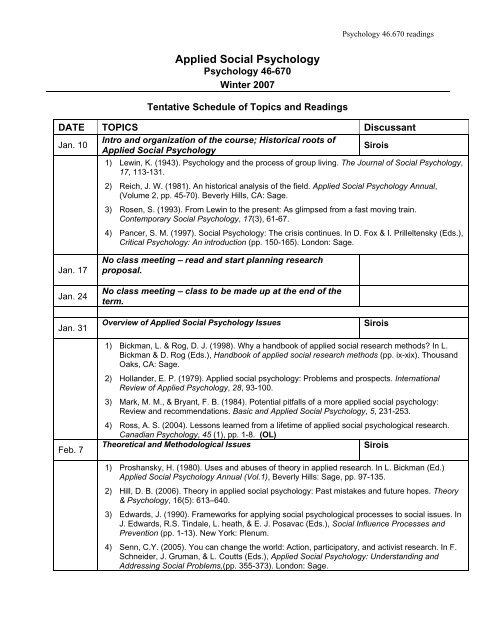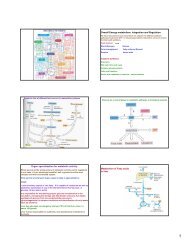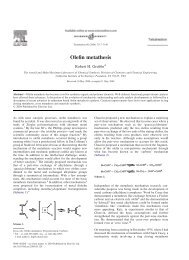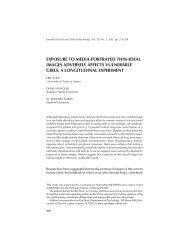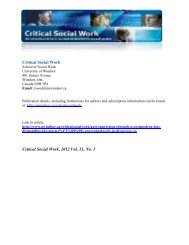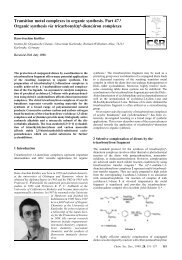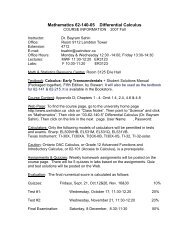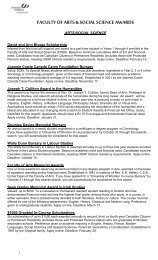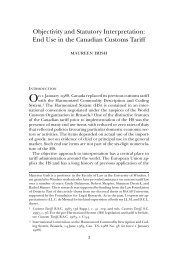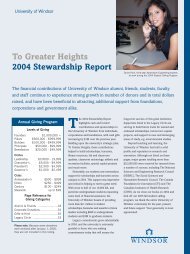Applied Social Psychology
Applied Social Psychology
Applied Social Psychology
You also want an ePaper? Increase the reach of your titles
YUMPU automatically turns print PDFs into web optimized ePapers that Google loves.
<strong>Applied</strong> <strong>Social</strong> <strong>Psychology</strong><br />
<strong>Psychology</strong> 46-670<br />
Winter 2007<br />
Tentative Schedule of Topics and Readings<br />
<strong>Psychology</strong> 46.670 readings<br />
DATE TOPICS Discussant<br />
Jan. 10<br />
Intro and organization of the course; Historical roots of<br />
<strong>Applied</strong> <strong>Social</strong> <strong>Psychology</strong><br />
Sirois<br />
Jan. 17<br />
Jan. 24<br />
Jan. 31<br />
Feb. 7<br />
1) Lewin, K. (1943). <strong>Psychology</strong> and the process of group living. The Journal of <strong>Social</strong> <strong>Psychology</strong>,<br />
17, 113-131.<br />
2) Reich, J. W. (1981). An historical analysis of the field. <strong>Applied</strong> <strong>Social</strong> <strong>Psychology</strong> Annual,<br />
(Volume 2, pp. 45-70). Beverly Hills, CA: Sage.<br />
3) Rosen, S. (1993). From Lewin to the present: As glimpsed from a fast moving train.<br />
Contemporary <strong>Social</strong> <strong>Psychology</strong>, 17(3), 61-67.<br />
4) Pancer, S. M. (1997). <strong>Social</strong> <strong>Psychology</strong>: The crisis continues. In D. Fox & I. Prilleltensky (Eds.),<br />
Critical <strong>Psychology</strong>: An introduction (pp. 150-165). London: Sage.<br />
No class meeting – read and start planning research<br />
proposal.<br />
No class meeting – class to be made up at the end of the<br />
term.<br />
Overview of <strong>Applied</strong> <strong>Social</strong> <strong>Psychology</strong> Issues Sirois<br />
1) Bickman, L. & Rog, D. J. (1998). Why a handbook of applied social research methods? In L.<br />
Bickman & D. Rog (Eds.), Handbook of applied social research methods (pp. ix-xix). Thousand<br />
Oaks, CA: Sage.<br />
2) Hollander, E. P. (1979). <strong>Applied</strong> social psychology: Problems and prospects. International<br />
Review of <strong>Applied</strong> <strong>Psychology</strong>, 28, 93-100.<br />
3) Mark, M. M., & Bryant, F. B. (1984). Potential pitfalls of a more applied social psychology:<br />
Review and recommendations. Basic and <strong>Applied</strong> <strong>Social</strong> <strong>Psychology</strong>, 5, 231-253.<br />
4) Ross, A. S. (2004). Lessons learned from a lifetime of applied social psychological research.<br />
Canadian <strong>Psychology</strong>, 45 (1), pp. 1-8. (OL)<br />
Theoretical and Methodological Issues Sirois<br />
1) Proshansky, H. (1980). Uses and abuses of theory in applied research. In L. Bickman (Ed.)<br />
<strong>Applied</strong> <strong>Social</strong> <strong>Psychology</strong> Annual (Vol.1), Beverly Hills: Sage, pp. 97-135.<br />
2) Hill, D. B. (2006). Theory in applied social psychology: Past mistakes and future hopes. Theory<br />
& <strong>Psychology</strong>, 16(5): 613–640.<br />
3) Edwards, J. (1990). Frameworks for applying social psychological processes to social issues. In<br />
J. Edwards, R.S. Tindale, L. heath, & E. J. Posavac (Eds.), <strong>Social</strong> Influence Processes and<br />
Prevention (pp. 1-13). New York: Plenum.<br />
4) Senn, C.Y. (2005). You can change the world: Action, participatory, and activist research. In F.<br />
Schneider, J. Gruman, & L. Coutts (Eds.), <strong>Applied</strong> <strong>Social</strong> <strong>Psychology</strong>: Understanding and<br />
Addressing <strong>Social</strong> Problems,(pp. 355-373). London: Sage.
<strong>Psychology</strong> 46.670 readings<br />
DATE TOPICS Discussant<br />
Feb. 14 Career Opportunities and Grant writing Sirois<br />
1) Sternberg, R. J. (2004). Obtaining a research grant: The applicant’s view. In J. M. Darley, M. P.<br />
Zanna, & H. L. Roediger (Eds.), The compleat academic: A career guide, 2nd Edition, (pp.169-<br />
184). Washington, DC: American Psychological Association.<br />
2) Oskamp, S. (1988). Nontraditional employment opportunities for applied psychologists. American<br />
Psychologist, 43(6), 484-485.<br />
3) Ballie, R. (Dec., 2001). Where are the new psychologists going? Monitor on <strong>Psychology</strong>, 24-25.<br />
http://www.apa.org/monitor/dec01/wheregoing.html<br />
4) Robson, C. (1993). Appendix A: Writing a project proposal (pp. 464-469). In Real World<br />
Research: A resource for social scientists and practitioner-researchers, Oxford: Blackwell.<br />
Feb. 21<br />
Proposal topic presentations and peer review<br />
Brief presentation by each class member followed by group feedback.<br />
Feb. 28 Study Break – no class<br />
Mar. 7 Community <strong>Psychology</strong> 1 Andrea<br />
1) Walsh-Bowers, Richard (1998). Community psychology in the Canadian psychological family.<br />
Canadian <strong>Psychology</strong>, 39(4) 280-287. (OL)<br />
2) Prilletensky, I. & Nelson, G. (1997). Community <strong>Psychology</strong>: Reclaiming social justice. In D. Fox,<br />
& I. Prilletensky (Eds.), Critical psychology: An introduction (pp. 150-165). London: Sage.<br />
3) Fryer, D., & Fagan, R. (2003). Toward a Critical Community Psychological Perspective on<br />
Unemployment and Mental Health Research. American Journal of Community <strong>Psychology</strong>, 32<br />
(1), 89-96. (OL)<br />
Mar. 14 Community <strong>Psychology</strong> 2 Shelly<br />
1) Krahé, B., & Altwasser, C. (2006). Changing negative attitudes towards persons with physical<br />
disabilities: an experimental intervention. Journal of Community & <strong>Applied</strong> <strong>Social</strong> <strong>Psychology</strong>,<br />
16(1), 59-69. (OL)<br />
2) Bybee, D., & Sullivan, C. M. (2003). The process through which an advocacy intervention<br />
resulted in positive change for battered women over time. American Journal of Community<br />
<strong>Psychology</strong>, 30 (1), 103-132. (OL)<br />
3) Dunham, P. J., Hurshman, A., Litwin, E., Gusella, J., Ellsworth, C., & Dodd, P. W. D. (1998).<br />
Computer-mediated social support: Single young mothers as a model system. American Journal<br />
of Community <strong>Psychology</strong>, 26(2), 281-306. (OL)<br />
Mar. 21 Health <strong>Psychology</strong> 1 Barat<br />
1) Ogden, J. (2003). Some problems with social cognition models: A pragmatic and conceptual<br />
analysis. Health <strong>Psychology</strong>, 22(4), 424-428. (OL)<br />
2) Morrison, D. M., Baker, S. A., & Gillmore, M. R. (2000). Using the theory of reasoned action to<br />
predict condom use among high-risk heterosexual teens. In P. Norman, C. Abraham, & M.<br />
Conner (Eds). Understanding and changing health behavior: From health beliefs to selfregulation<br />
(pp. 27-49). Amsterdam: Harwood.<br />
3) Sirois, F. M., Davis, C. G., & Morgan, M. (2006). “Learning to live with what you can’t rise above”:<br />
Control beliefs, symptom control, and adjustment to tinnitus. Health <strong>Psychology</strong>, 25(1), 119-123.<br />
(OL)<br />
4) Barlow, J. H., Bancroft, G. V., & Turner, A. P. (2005). Self-management training for people with<br />
All
<strong>Psychology</strong> 46.670 readings<br />
chronic disease: A shared learning experience. Journal of Health <strong>Psychology</strong>, 10(6), 863-872.<br />
(OL)<br />
Mar. 28 Health <strong>Psychology</strong> 2 Melissa<br />
1) Borg, M. B. (2002). The Avalon Garden’s Men’s Association: A community health psychology<br />
case study. Journal of Health <strong>Psychology</strong>, 7 (3), 345-357. (OL)<br />
2) Hobfoll, S. E., Jackson, A. P., Lavin, J., Britton, P. J., et al (1994). Reducing inner-city women's<br />
AIDS risk activities: A study of single, pregnant women. Health <strong>Psychology</strong>, 13(5), 397-403. (OL)<br />
3) Deacon, H. (2006). Towards a sustainable theory of health-related stigma: Lessons from the<br />
HIV/AIDS literature. Journal of Community & <strong>Applied</strong> <strong>Social</strong> <strong>Psychology</strong>.Special Issue:<br />
Understanding and Challenging Stigma, 16(6), 418-425. (OL)<br />
DATE TOPICS Discussant<br />
April 4 Industrial/Organizational <strong>Psychology</strong> 1 Pamela<br />
1) Seijts, G. H., & Latham, B. W. (2003). Creativity through applying ideas from fields other than<br />
one's own: Transferring knowledge from social psychology to Industrial/Organizational<br />
<strong>Psychology</strong>. Canadian <strong>Psychology</strong>, 44(3), 232-239. (OL)<br />
2) Lyness, K. S., & Heilman, M. E. (2006). When fit is fundamental: Performance evaluations and<br />
promotions of upper-level female and male managers. Journal of <strong>Applied</strong> <strong>Psychology</strong>, 91(4),<br />
777-785. (OL)<br />
3) Struthers, C. W., Dupuis, R., & Eaton, J. (2005). Promoting forgiveness among co-workers<br />
following a workplace transgression: The effects of social motivation training. Canadian Journal<br />
of Behavioural Science.Special Issue: Building Healthy Workplaces: What We Know So Far,<br />
37(4), 299-308. (OL)<br />
April 11 Industrial/Organizational <strong>Psychology</strong> 2 Joanna<br />
1) Ilgen, D. R. (1990). Health issues at work: Opportunities for industrial/organizational psychology.<br />
American Psychologist. 45(2), 273-283. (OL).<br />
2) Mantler, J., Matejicek, A., Matheson, K., & Anisman, H. (2005). Coping with employment<br />
uncertainty: A Comparison of employed and unemployed workers. Journal of Occupational<br />
Health <strong>Psychology</strong>, 10(3), 200-209. (OL).<br />
3) Brown, D. J., Cober, R. T., Keeping, L. M., & Levy, P. E. (2006). Racial tolerance and reactions<br />
to diversity information in job advertisements. Journal of <strong>Applied</strong> <strong>Social</strong> <strong>Psychology</strong>, 36(8), 2048-<br />
2071. (OL).<br />
April 18 Other <strong>Applied</strong> <strong>Social</strong> <strong>Psychology</strong> topics Kristen<br />
1) Abrahamse, W., Steg, L., Vlek, C., & Rothengatter, T. (2005). A review of intervention studies<br />
aimed at household energy conservation. Journal of Environmental <strong>Psychology</strong>, 25(3), 273-291.<br />
(OL).<br />
2) Halpern, D. F., & Desrochers, S. (2005). <strong>Social</strong> psychology in the classroom: Applying what we<br />
teach as we teach it. Journal of <strong>Social</strong> & Clinical <strong>Psychology</strong>.Special Issue: Dispelling the Fable<br />
of "Those Who Can, Do, and Those Who Can't, Teach:" The (<strong>Social</strong> and Clinical) <strong>Psychology</strong> of<br />
Instruction, 24(1), 51-61. (OL).<br />
3) Ochsner, K. N., & Lieberman, M. D. (2001). The emergence of social cognitive neuroscience.<br />
American Psychologist, 56(9), 717-734. (OL).<br />
Course wrap up<br />
(OL) = reading available electronically as full text-articles through the Leddy Library<br />
* Several of the suggested readings are from a previous version of this course taught by Charlene Senn. I would<br />
like to gratefully acknowledge the help of Charlene Senn in the development of the current course’s reading list.


